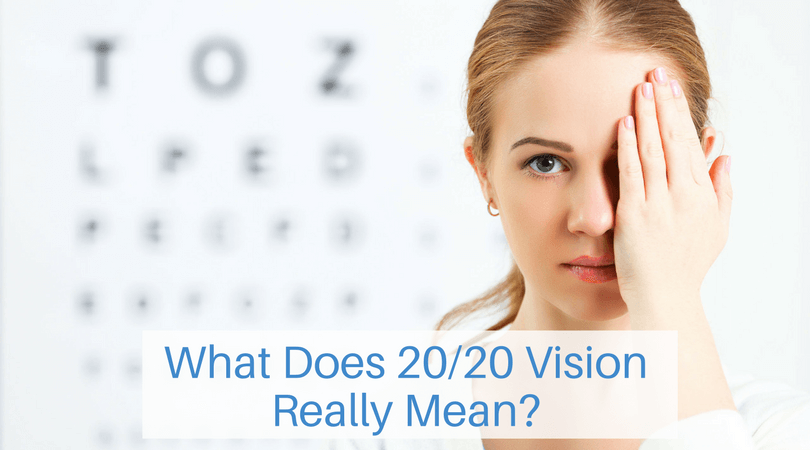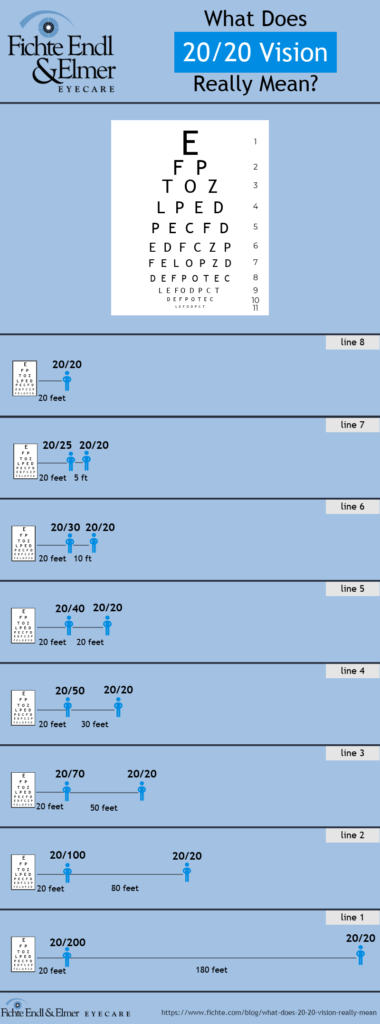
Have you ever wondered about those numbers your eye doctor mentions during an exam? When your eye doctor reports “20/20” or “20/40” vision, they’re describing your visual acuity, which is the sharpness and clarity of your eyesight.
But what do these measurements actually signify, and why is 20/20 vision considered the gold standard? Let’s explore the science behind these numbers and what they mean for your eye health.
How Vision Is Measured: The Snellen Chart
Visual acuity is measured by the Snellen chart, which typically features 11 rows of capital letters. It starts with one large letter, and as the rows continue, the font size decreases.
Vision is tested by looking at the chart from 20 feet away. You will cover one eye while reading with the other eye. Each line is coordinated with a vision level, ranging from 20/400 to 20/10.
What Is 20/20 Vision?
20/20 vision means a person has optimal vision from a distance of 20 feet.
The first number (20) represents the testing distance in feet—how far you stand from the chart. The second number indicates the distance at which a person with standard vision can read the same line.
So when someone has 20/20 vision, it means they can clearly see at 20 feet what a person with normal vision can see at 20 feet. Essentially, they have standard visual acuity. If you have 20/30 vision, it means you must stand at 20 feet to see what someone with standard vision can see from 30 feet away. In other words, objects must be closer for you to see them with the same clarity as someone with 20/20 vision.
Conversely, if you have 20/15 vision (better than standard), you can see clearly at 20 feet what a person with normal vision needs to stand at 15 feet to see.
Vision Health Factors Beyond The Chart
It’s important to note that having 20/20 vision does not necessarily mean your vision is perfect. This scale only determines visual clarity from a distance.
Complete visual health encompasses much more than just reading a distant chart clearly. A comprehensive understanding of your eye health includes numerous factors beyond basic visual acuity.
Peripheral vision allows you to detect objects at the edges of your visual field while looking straight ahead. Depth perception helps you accurately judge distances between objects, while color vision enables you to distinguish between different hues and shades.
Your visual system also relies on proper coordination between both eyes, the ability to focus quickly on objects at varying distances, and effective processing of visual information by your brain. Some serious eye diseases like cataracts, glaucoma, and macular degeneration can develop regardless of your visual acuity measurement and require professional diagnosis.
The Importance of Regular Eye Exams
A full eye examination goes far beyond the simple Snellen chart test. During a comprehensive eye exam, your eye doctor will evaluate all aspects of your visual system through various tests.
These regular check-ups are crucial because many eye diseases develop without early symptoms, and vision changes often happen so gradually that they go unnoticed without professional evaluation. The good news is that there are numerous solutions to help you achieve optimal vision.
Whether through prescription glasses, contact lenses, LASIK surgery, or other advanced treatments, most vision conditions can be effectively managed or corrected based on your specific needs and lifestyle.
Is it time for you to have an eye exam? Do you want to learn where you fall on the vision scale? Schedule an appointment at Fichte, Endl, & Elmer Eyecare in Buffalo, NY, or call us at 1-800-309-2020. You can see an in-house optometrist, or you can get in even quicker if you see one of our virtual doctors and have a remote eye exam!



